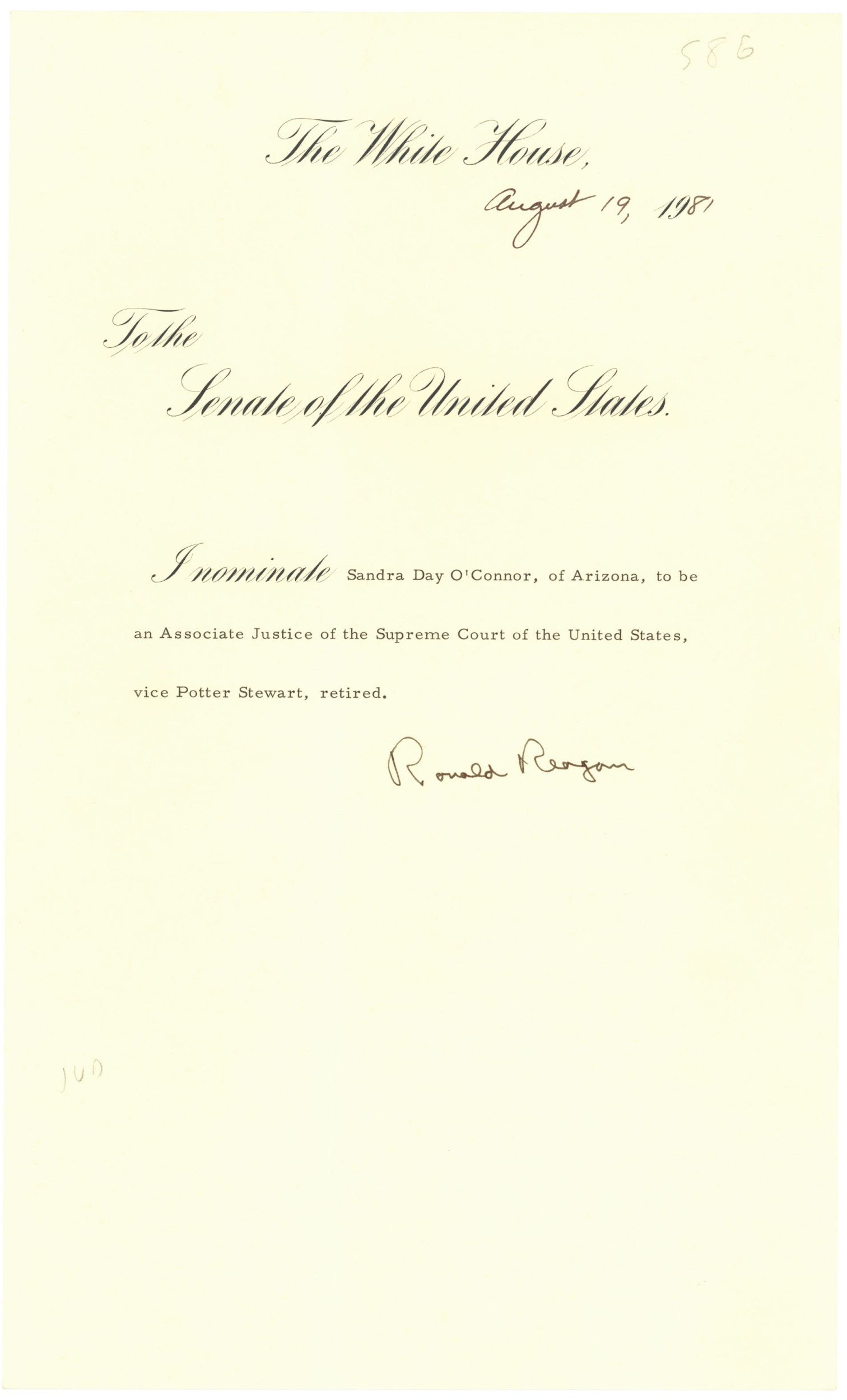Nomination of Sandra Day O'Connor as Supreme Court Justice
8/19/1981
Add to Favorites:
Add all page(s) of this document to activity:

During Ronald Reagan’s 1980 campaign for President, he promised to nominate a woman for the Supreme Court. President Reagan followed through on this pledge on August 19, 1981, by nominating Arizona State Court of Appeals Judge Sandra Day O’Connor. The U.S. Senate confirmed O’Connor on September 22, 1981.
O’Connor, who spent part of her childhood on a family ranch in Arizona, graduated from Stanford with a law degree. At a time when opportunities were limited for women—at least 40 law firms refused to consider her—she worked for free for the San Mateo county attorney.
Eventually she was the state assistant attorney general in Arizona from 1965 to 1969, and also served two terms in the Arizona state senate. When President Reagan nominated to the Supreme Court, her appointment garnered unanimous Senate approval. She served 24 years on the Supreme Court before her retirement in 2006.
O’Connor’s influence on the court was immense, as she often acted as a swing vote on key decisions. Some of the notable cases that O’Connor worked on include Bush v. Gore (2000), which confirmed George W. Bush as President, and Planned Parenthood v. Casey (1992), which helped uphold the Roe v. Wade (1973) decision that legalized abortion. And she was the deciding vote on a number of anti-discrimination and civil rights related cases.
O’Connor, who spent part of her childhood on a family ranch in Arizona, graduated from Stanford with a law degree. At a time when opportunities were limited for women—at least 40 law firms refused to consider her—she worked for free for the San Mateo county attorney.
Eventually she was the state assistant attorney general in Arizona from 1965 to 1969, and also served two terms in the Arizona state senate. When President Reagan nominated to the Supreme Court, her appointment garnered unanimous Senate approval. She served 24 years on the Supreme Court before her retirement in 2006.
O’Connor’s influence on the court was immense, as she often acted as a swing vote on key decisions. Some of the notable cases that O’Connor worked on include Bush v. Gore (2000), which confirmed George W. Bush as President, and Planned Parenthood v. Casey (1992), which helped uphold the Roe v. Wade (1973) decision that legalized abortion. And she was the deciding vote on a number of anti-discrimination and civil rights related cases.
Transcript
[upper right corner in pencil] 586The White House,
August 19, 1981
To the
Senate of the United States.
I nominate Sandra Day O'Connor, of Arizona, to be an Associate Justice of the Supreme Court of the United States, vice Potter Stewart, retired.
[signature] Ronald Reagan
This primary source comes from the Records of the U.S. Senate.
National Archives Identifier: 595429
Full Citation: Nomination of Sandra Day O'Connor as Supreme Court Justice; 8/19/1981; Executive Nominations, 1789 - 2002; Records of the U.S. Senate, Record Group 46; National Archives Building, Washington, DC. [Online Version, https://docsteach.org/documents/document/nomination-sandra-day-oconnor, April 26, 2024]Activities that use this document
- The Constitution at Work: Elementary Edition
Created by the National Archives Education Team - The Three Branches of Government
Created by the National Archives Education Team
Rights: Public Domain, Free of Known Copyright Restrictions. Learn more on our privacy and legal page.



